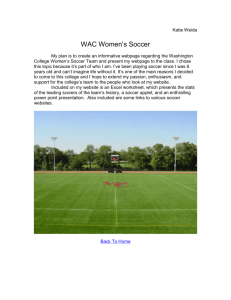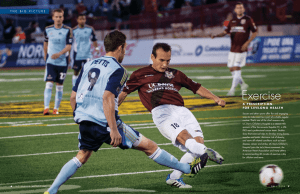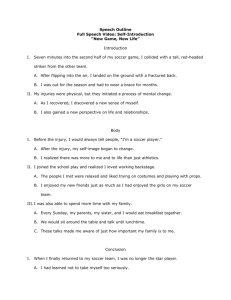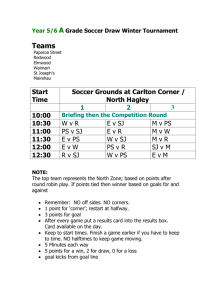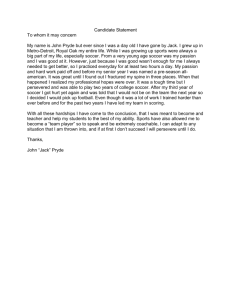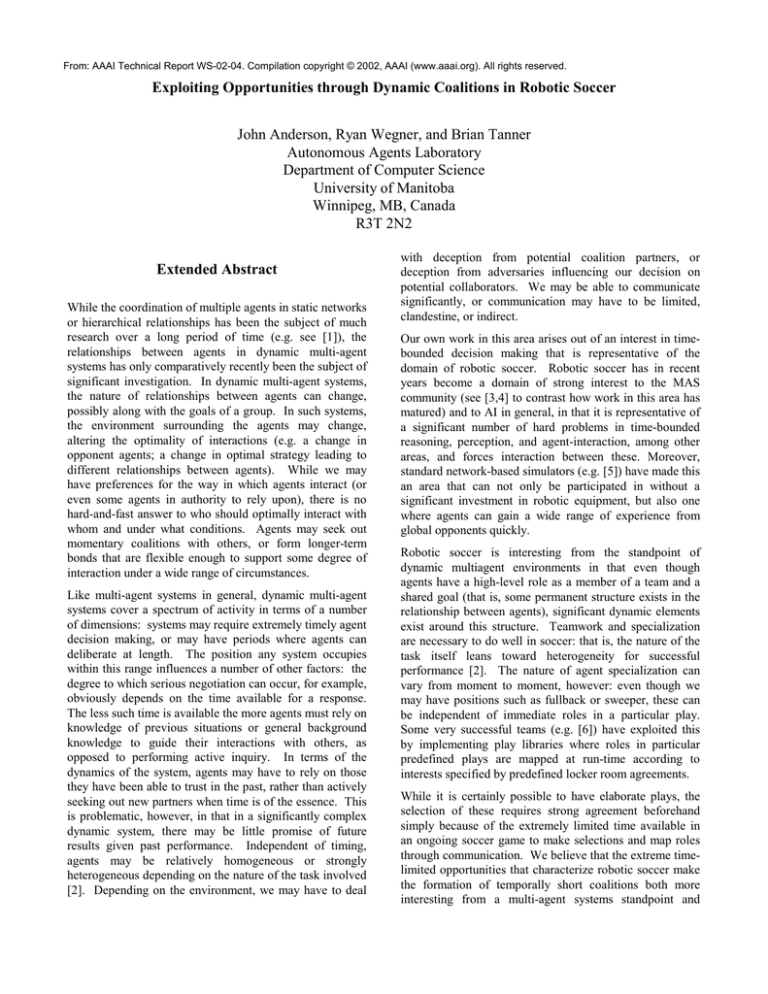
From: AAAI Technical Report WS-02-04. Compilation copyright © 2002, AAAI (www.aaai.org). All rights reserved.
Exploiting Opportunities through Dynamic Coalitions in Robotic Soccer
John Anderson, Ryan Wegner, and Brian Tanner
Autonomous Agents Laboratory
Department of Computer Science
University of Manitoba
Winnipeg, MB, Canada
R3T 2N2
Extended Abstract
While the coordination of multiple agents in static networks
or hierarchical relationships has been the subject of much
research over a long period of time (e.g. see [1]), the
relationships between agents in dynamic multi-agent
systems has only comparatively recently been the subject of
significant investigation. In dynamic multi-agent systems,
the nature of relationships between agents can change,
possibly along with the goals of a group. In such systems,
the environment surrounding the agents may change,
altering the optimality of interactions (e.g. a change in
opponent agents; a change in optimal strategy leading to
different relationships between agents). While we may
have preferences for the way in which agents interact (or
even some agents in authority to rely upon), there is no
hard-and-fast answer to who should optimally interact with
whom and under what conditions. Agents may seek out
momentary coalitions with others, or form longer-term
bonds that are flexible enough to support some degree of
interaction under a wide range of circumstances.
Like multi-agent systems in general, dynamic multi-agent
systems cover a spectrum of activity in terms of a number
of dimensions: systems may require extremely timely agent
decision making, or may have periods where agents can
deliberate at length. The position any system occupies
within this range influences a number of other factors: the
degree to which serious negotiation can occur, for example,
obviously depends on the time available for a response.
The less such time is available the more agents must rely on
knowledge of previous situations or general background
knowledge to guide their interactions with others, as
opposed to performing active inquiry. In terms of the
dynamics of the system, agents may have to rely on those
they have been able to trust in the past, rather than actively
seeking out new partners when time is of the essence. This
is problematic, however, in that in a significantly complex
dynamic system, there may be little promise of future
results given past performance. Independent of timing,
agents may be relatively homogeneous or strongly
heterogeneous depending on the nature of the task involved
[2]. Depending on the environment, we may have to deal
with deception from potential coalition partners, or
deception from adversaries influencing our decision on
potential collaborators. We may be able to communicate
significantly, or communication may have to be limited,
clandestine, or indirect.
Our own work in this area arises out of an interest in timebounded decision making that is representative of the
domain of robotic soccer. Robotic soccer has in recent
years become a domain of strong interest to the MAS
community (see [3,4] to contrast how work in this area has
matured) and to AI in general, in that it is representative of
a significant number of hard problems in time-bounded
reasoning, perception, and agent-interaction, among other
areas, and forces interaction between these. Moreover,
standard network-based simulators (e.g. [5]) have made this
an area that can not only be participated in without a
significant investment in robotic equipment, but also one
where agents can gain a wide range of experience from
global opponents quickly.
Robotic soccer is interesting from the standpoint of
dynamic multiagent environments in that even though
agents have a high-level role as a member of a team and a
shared goal (that is, some permanent structure exists in the
relationship between agents), significant dynamic elements
exist around this structure. Teamwork and specialization
are necessary to do well in soccer: that is, the nature of the
task itself leans toward heterogeneity for successful
performance [2]. The nature of agent specialization can
vary from moment to moment, however: even though we
may have positions such as fullback or sweeper, these can
be independent of immediate roles in a particular play.
Some very successful teams (e.g. [6]) have exploited this
by implementing play libraries where roles in particular
predefined plays are mapped at run-time according to
interests specified by predefined locker room agreements.
While it is certainly possible to have elaborate plays, the
selection of these requires strong agreement beforehand
simply because of the extremely limited time available in
an ongoing soccer game to make selections and map roles
through communication. We believe that the extreme timelimited opportunities that characterize robotic soccer make
the formation of temporally short coalitions both more
interesting from a multi-agent systems standpoint and
potentially more successful in the game itself. By a
momentary coalition, we mean the explicit recognition that
one can be of use to a teammate in an upcoming moment,
and the understanding on the part of two or more
teammates, verbally or non-verbally, that some opportunity
will be exploited between them. An example of such
behaviour would be possessing the ball, seeing an open
teammate, and receiving a signal from that teammate that
they understand the opportunity to achieve a shared goal.
A relationship between the two players is momentarily
formed over and above any other relationships that
currently exist. This relationship may end immediately (I
pass the ball), or may continue for some time (I continue up
an open channel in the field as a teammate works to keep
that channel open). This is as opposed to an elaborate play
relying upon understood relationships beforehand and premapped actions as the play unfolds, or on individual
behaviours that recognize no relationships with teammates
(e.g. kicking the ball forward and someone else happening
to be there and moving it further, with no recognized
connection on the part of either agent).
Such opportunities are certainly prevalent in human soccer,
especially at the midfield position where human agents are
expected to get a feel for the overall pace of the game,
move the ball up channels, and function to some degree
both offensively and defensively. We are working on
agents that form momentary coalitions in this manner, and
then allow those coalitions to dissipate after the reason for
their formation is complete. These agents are being
developed in Java using the Robocup soccer server [5] as a
test environment, and employ verbal communication
through directed and non-directed signals such as "I'm
open". This will be extended to non-verbal communication
through recognizing a movement pattern in lieu of the
server's ability to employ realistic human movements such
as waving to an opponent as a signal. We are working
largely with two player coalitions, and limited three-player
coalitions (a pass while another agent keeps an opponent at
a distance, or distracted). This decision is based on the
observed behaviour in humans in soccer: in practice, larger
spontaneous coalitions in this domain are rare in humans
simply because of the problems of recognizing
opportunities between several agents in real time and the
problems of diverting focus between several other
teammates as well as the ball and one's opponents. Once
complete, these will serve as a basis for empirically
examining the performance of dynamic coalition formation
in robotic soccer from the standpoint of parsimony. That
is, answer the question of whether such agents can give a
performance gain over pure individual behaviours that
approaches the use of elaborate large scale plays and the
accompanying elaborate representations those require.
This encompasses a number of issues of interest to the
community, including:
The communication and interpretation of intent
under time bounds in order to recognize the
potential for short-term coalitions;
Making judgments in real time as to the suitability
of other agents for such dynamic coalitions;
Determining when such a coalition has ended and
that its assumed affects on the behaviour of
another agent can no longer be relied upon; and
Developing the greater potential to engage in such
coalitions with agents over time as they become
more trusted.
The latter is an extremely important issue in its own right
that represents a crossover to another area in which we are
working, multi-agent learning through peer reinforcement
[7]. In this situation, agents are expected to learn a multiagent task such as the acquisition of behaviours for playing
soccer through the reinforcement of peers that are also
participating in the same task. However, agents have to
gauge the value of reinforcements they receive with their
perception of its accuracy, this requires developing trust in
the abilities (and in other domains, the motivation) of the
agent providing the reinforcements. To this end, learning
improves in proportion to the degree that such trust is
perceived, and agents must selectively filter reinforcements
based on the agent providing it. Within this, we are
currently working to examine coalition formation over time
and the gradual learning of agents to select as potential
coalition partners as well as the settings in which such
coalitions are most effective.
We are also working on porting this to scenarios beyond
robotic soccer through the more generic player/stage
platform [8] provided by the USC robotics laboratory.
Bibliography
[1] Bond, A., and L. Gasser, Readings in Distributed
Artificial Intelligence (San Francisco: Morgan
Kaufmann), 1988. 649 pp.
[2] Balch, Tucker, Behavioural Diversity in Learning
Robot Teams, Ph.D. Dissertation, Computer Science,
Georgia Tech, 1998.
[3] Kitano, H., Tambe, M., and Stone, P., "The RoboCup
Synthetic Agent Challenge 97", Proceedings of the
Fifteenth International Joint Conference on Artificial
Intelligence, Nagoya, Japan, 1997, pp. 24-29.
[4] Stone, P., T. Balch, and G. Kraetzschmar (Eds.),
RoboCup 2000: Robot Soccer World Cup IV
(Heidelberg: Springer-Verlag), 2001. 658 pp.
[5] Noda, I., H. Matsubara, K. Hiraki and I. Frank.
“Soccer Server: a Tool for Research on Multi-Agent
Systems”, Applied Artificial Intelligence 12(2-3,
1998):233-250.
[6] Stone, P., and M. Veloso, "Task Decomposition and
Dynamic Role Assignment for Real-Time Strategic
Teamwork", Proceedings of the 5th International
Workshop on Agent Theories, Architectures, and
Languages (ATAL-98), pp. 293-308, 1998.
[7] Anderson, J., Tanner, B., and Wegner, R., "Peer
Reinforcement in Homogeneous and Heterogeneous
Multi-agent Learning", submitted to the 2002 IASTED
International Conference on AI and Soft Computing,
Banff, AB., June, 2002.
[8] Gerkey, B. P., R. T. Vaughan, K. Stoy, A. Howard, G.
S. Sukhatme, and M. J. Mataric, "Most Valuable
Player: A Robot Device Server for Distributed
Control", Proceedings of the IEE/RSJ International
Conference on Intelligent Robots and Systems,
Montreal, 2001, pp. 1226-1231.



